- "Inside this file you'll find everything you need to know about Robot Wars. There are seven sensational sections jam-packed with information about your favourite bots. There are even interviews with the Robot Wars team - and loads of amazing robot trivia to keep you and your friends amused for hours.
As well as containing all the info on Robot Wars you'll ever need to know, your Fun file has lots of space for you to fill in details about yourself, to record numbers and addresses of your friends and to plan the year ahead!
At the back of the file you'll find some great stickers too!" - — Introduction on reverse front page
The Robot Wars File (also generally referred to as the Robot Wars Funfax[1] or Robot Wars Fun Fax[2]) was a Funfax book written by Mark Hillsdon and published by Funfax Ltd. (by then a subsidiary of Dorling Kindersley) on Thursday 25 October 2001, one day before the airing of Robot Wars Extreme: Series 1 on BBC Two. As with other books in the series, it was a "loose leaf" book, consisting of a small hardback book with the pages held in metal ring binders. The File had most of the features common in all the Funfax books, except with a predominantly Robot Wars theme. The book featured information on the show up to the (then) most recent series broadcast, The Fourth Wars.
Personal[]
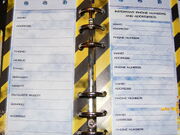
The "Personal" section, with spaces to write personal information and contact details
As with other Funfax titles, the Robot Wars File started with a Personal section. After a brief introductory page, readers could add personal information about themselves as well as contact details of their friends and accomplices into the provided spaces, in a similar manner to an address book.
The same section also featured four pages where readers could write short biographies of their favourite robots, including name, team captain, track record, seedings, best and worst moments, and best battle, as well as a space to stick a picture of their chosen robots.
Finally, there was a small sub-section called Design Your Own Robot, which offered readers three pages with spaces to design their own robot. Each space enabled them to write and draw each specific part of the robot, including its basic shape, weapons, where the components would come from and ideas for decorations. The last page featured a large space to draw a final diagram of the robot.
Diary[]
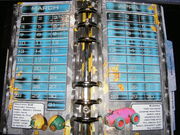
The diary, featuring small descriptions of robots from Series 3-4
Another feature shared with other Funfax books, the Robot Wars File contained a Diary. As well as a single page at the beginning of the section where readers could make notes of upcoming Robot Wars-related events, this featured twelve pages for each month, with dates and a short paragraph on a competitor robot from Series 4 at the bottom (with the exception of April, which had Robopig as the featured robot). The last page featured a section called Top Ten Robots that Didn't Make It, where readers could write down their personal suggestions, although the page actually only had six spaces.
The robots for each month in the Diary section were:
- January - Robochicken
- February - Scorpion
- March - Milly-Ann Bug
- April - Robopig
- May - Major Tom
- June - MouseTrap
- July - The Creature
- August - War Hog
- September - Destruct-A-Bubble
- October - Attila the Drum
- November - Banshee
- December - Diotoir
In addition to the aforementioned robots, an image of Velocirippa was used for the Top Ten Robots that Didn't Make it page.
History of The Robot[]
This section was divided into four sub-sections:
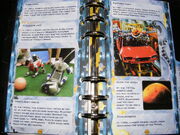
Sample of the "History of The Robot" section
History of The Robot highlighted many notable robots and robotics-related milestones, including:
- Autonomous water driven clocks invented by the Ancient Egyptians around 500BC.
- A mechanical cockerel from 1350, used on a French Cathedral and said to have 'flapped its wings and crowed every day at noon'.
- A life-sized chess-playing automaton from 1769, which was later discovered to have been controlled by a small man operating from inside.
- An 1801 invention from Joseph Jacquard capable of receiving instructions from cards with holes punched through them.
- Czech playwright Karel Capek coining the term "robot" in his 1921 play, Rossum's Universal Robots.
- "Electro" and "Sparko", the first robots to move through using electric motors.
- Aibo, a robot dog from Sony, which in 1999 sold 3,000 units within 20 minutes.
- 'Unimate', the first robot to work on a car production line in 1961 - half of all robots were used in car factories by the time of this book's publication.
- The first robot to walk on Mars, Sojourner from 1997.
- 'Jason', a robot camera used to discover the wreck of the Titanic in 1986.
Robots of Today described the most notable robots being developed and used around the time of the book's publication. These included:
- Robotic fruit-pickers, fuelling stations and waiters.
- 'Gastrobots', a robotic slug that feeds on other slugs.
- 'Roboguard', a Thai security robot using infra-red sensors and a laser-sighted gun to track criminals.
- 'Care-O-Bots', such as the Honda P-3, developed for domestic household use. The P-3 pictured was mentioned as capable of walking in a straight line, turning corners, walking up a flight of stairs and navigating around furniture in a similar way to humans.
- An unnamed rescue robot - still being developed by the time of publication - designed to walk through minefields or collapsed buildings.
- The Lego 'Mindstorms' range, offering customers the chance to build and program their own robots.
- Takara jellyfish, fish and turtle robots from Japan, capable of changing direction upon hitting aquarium walls and proven to sooth nerves and reduce stress.
- Sony's SDR-3X, a sophisticated walking robot designed to play football.
Famous Robots, a single page briefly mentioning robots and androids from film and TV, such as:
- Maria, from Metropolis (1927).
- Robbie the Robot from the 1950s sci-fi TV series, Forbidden Planet.
- C-3PO and R2-D2 from the Star Wars film franchise.
What Does the Future Hold?; a single page offering glimpses into the then-latest developments in robotics:
- 'Robomaus', the world's smallest robot at just a nanometre in size. Its section speculated on the development of 'nanorobots' which could be injected into the human body and used to 'help repair it from inside.'
- Surgery robots, with hands steadier than those of a human and capable of performing more intricate operations.
- 'Polymorphic' robots that can melt down, change shape and recycle themselves into a new robot.
Hall of Fame[]
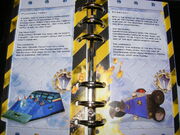
Two of the profiles featured in the "Hall of Fame"
The Hall of Fame featured profiles of various robots from the Fourth Wars, as well as Roadblock (the Series 1 champion) and Plunderstorm, which for some unknown reason was featured instead of Plunderbird 4, the International Wreck Crew's entry for Series 4. Each profile mentioned an interesting fact about the robots featured - such as Atomic being made from old tractor parts, and Dominator 2 featuring a plasma nitride-coated titanium shell oven-baked for extra strength - as well as brief descriptions of their weaponry, past performances or how well it might perform in future series. Most of the profiles also featured a web address for each relevant team's website.
The robots profiled in this section were:
- Atomic
- Behemoth
- Bulldog Breed 2
- Chaos 2
- Dominator 2
- Eric
- Firestorm 2
- Gemini
- Hypno-Disc
- Kronic the Wedgehog
- Mortis
- 101
- Panic Attack
- Plunderstorm
- Pussycat
- Razer
- Road Block
- Stinger
- Steel Avenger
- Steg 2 (referred to simply as Steg)
- Splinter
- Suicidal Tendencies
- The Morgue
- Wheely Big Cheese
- Wild Thing
- X-Terminator 2 (referred to simply as X-Terminator)
The Secrets of the House[]
A double-sided, double-sized fold-out poster, common among most of the Funfax releases.
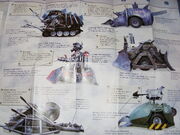
One side of the fold-out poster, showing the House Robots
The first side (The Secrets of the House) featured basic cross-sections of the six House Robots used at the time of Series 4. The cross-sections featured a short description of each House Robot as well as information on their weapons (or in Refbot's case, his features) and their 'weak spots'.
The other side (Primitive Prototypes) featured the original concept drawings for the House Robots. Some of these designs were developed into the House Robots used in the original series, others were rejected as too infeasible, and one, Shove was built, but otherwise not shown on television. The poster gives humorous accounts of how some of these conceptual House Robots were destroyed, "explaining" why they were not seen on television.
The original concept drawings were;
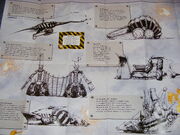
The other side of the poster, with the original House Robot concept drawings
- "Evildoer" – A prototype for Matilda, with an oval-shaped body, several saws along its back, cog-driven wheels and a rear chainsaw. The concept looked very similar to the finalised Matilda seen in the televised series.
- "Shove" – The inspiration for Shunt, featuring the same basic appearance as the latter but without an axe and designed to resemble a train rather than a bulldozer.
- "Phobia" – A flying robot, with helicopter blades and two chainsaws suspended from underneath. The description for this robot perpetuates it to have crash-landed on its first test flight.
- "The Sentinels" – Not to be confused with the House Robot used in Series 2. A large clusterbot consisting of two tall humanoid-like robots equipped with hooked arms and connected by a steel net used to trap other robots. The poster humorously claims that The Sentinels were destroyed when they had an argument and sliced through each other's power lines.
- "Hammerhead" – Designed after a shark, this robot had sharp steel teeth at the front, saw blades for wheels (similar to Saw Point) and an axe for a tail. Hammerhead was said to have eaten itself when its tail got stuck in its own teeth, according to its description.
- "A Taste of Kaos" – By far the biggest robot designed, this was a huge tracked robot with jet propulsion, two 'bionic' side arms with saw blades attached to the ends, and a hooked front ramming blade.
Behind the Scenes[]
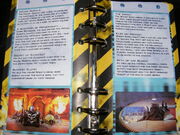
Part of the "Behind the Scenes" section
The penultimate section, Behind the Scenes, consisted of trivia and behind-the-scenes information on Robot Wars, alongside interviews with the show's personalities. This 14-page section featured:
- Brief information about the show's origins, from Marc Thorpe's conception of robot combat, to competitors from the American competitions and the UK series' televised debut.
- Information about the House Robots, the Robot Wars Arena, filming venues, side competitions and awards.
- A brief explanation of the rules surrounding judges' decisions.
- A prediction of the future, which discussed antweight robots, the weight limit increase for Series 5 and possible future combat robot developments, including hovercraft and machines with 'muscular' weapons.
- Lingo Madness - a short glossary of phrases and terminology frequently used in the show, including "Roboteers", "Grudge Matches" and "Excessive Evasion".
- In The Hot Seat – A series of short interviews with Jonathan Pearce, Julia Reed, Craig Charles and Philippa Forrester.
- Number Crunching – A final page of trivia featuring a selection of key statistics from Robot Wars. These included the number of people working to produce the show (126), the litres of gas used to fuel the flame hazards (80), and the number of applications for Series 5 (5,000).
Spare Parts[]
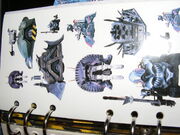
Some of the stickers included in "Spare Parts"
As with other Funfax books, the final section (Spare Parts) consisted of sets of stickers, bookmarks and door hangers. Stickers of the original Robot Wars logo, a selection of Series 4 competitors and the House Robots were included, along with two bookmarks and two door hangers.
Errors[]
The Robot Wars File had a number of printed errors, mostly in relation to series performances of the competitor robots featured:
- In the Diary, Diotoir is mentioned as having reached the Heat Final stage of the main competition in Series 1, 2, and 3, when at the time of writing, Diotoir had only progressed this far in Series 3. Its predecessor, Nemesis, had previously fallen at the Heat Semi-Final stage in Series 1 and 2.
- In the Hall of Fame entry for Mortis, it claims that Mortis is "The oldest fighting robot on the circuit", when Killertron made its first appearance in the same series as Mortis (Series 1), and was still competing at the time of publication, whereas Mortis had retired.
- Plunderstorm is included in The Hall of Fame instead of Plunderbird 4, the International Wreck Crew's Series 4 entry.
- The Hall of Fame entry for Roadblock states that it was the Series 2 runner-up, when it actually finished third.
- The Hall of Fame entry for Steg 2 simply calls the robot Steg.
- In the Hall of Fame section, Stinger, Steel Avenger, Steg 2 and Splinter are listed in the wrong order while 101 is mentioned between Mortis and Panic Attack instead of at the start. The order the aforementioned four robots should be listed is - Splinter, Steel Avenger, Steg 2, Stinger.
- In the Diary section, the images of Scorpion, Milly-Ann Bug, Major Tom, The Creature, Attila the Drum and Velocirippa are mirrored.
- Despite the last page of the Diary being called "Top Ten Robots that Didn't Make It", there are actually only six spaces.
- Panic Attack's Hall of Fame entry states that it went ten battles without defeat, although when counting its victories in Series 2 and 3, it actually won nine battles before its defeat at the hands of Fire Storm in the Series 3 Semi-Finals.
- C-3PO is misspelt as CP-30 in the "Famous Robots" section.
References[]
- ↑ Robot Wars File, p.1
- ↑ http://www.fightingrobots.co.uk/robotsrule/merchandise.htm
[]
| ||||||||||||||||||||
